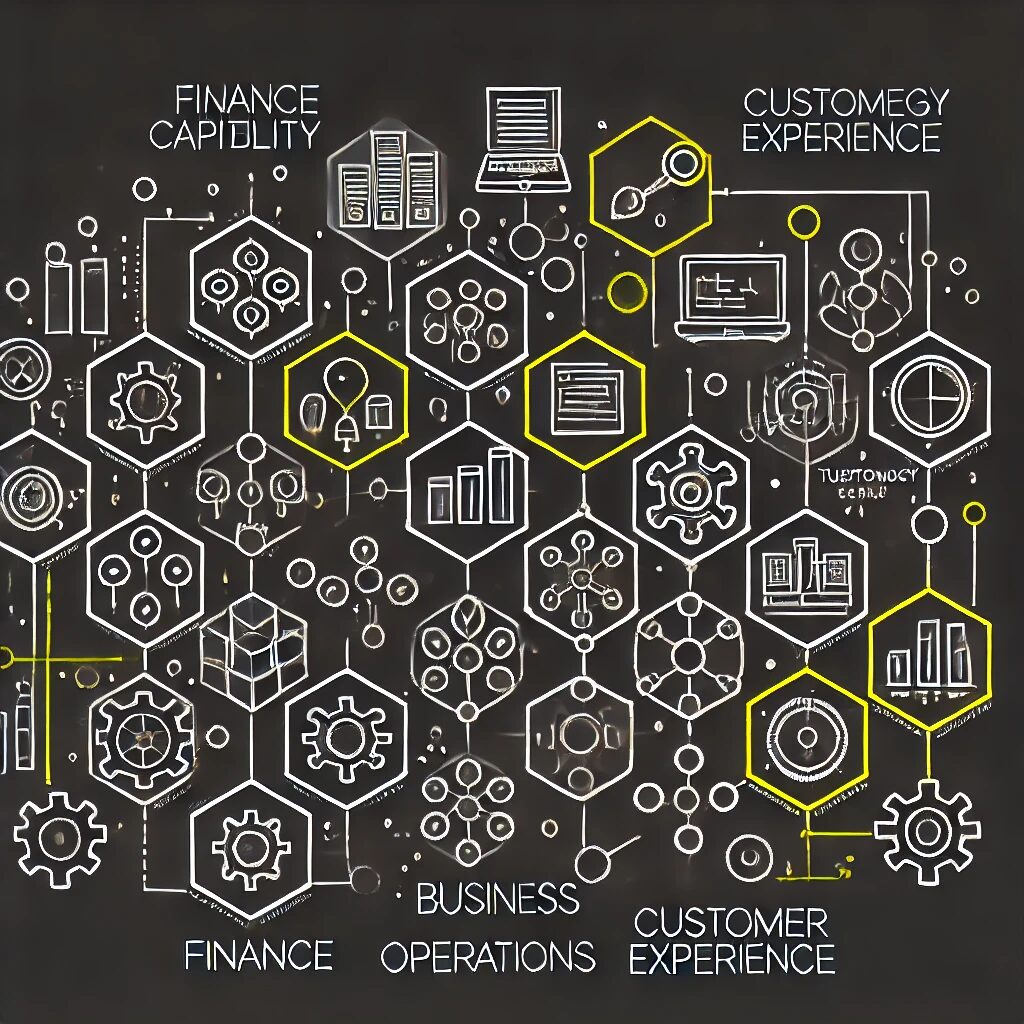
Capability Mapping Blueprint for Retail Excellence. Transform Your Retail Enterprise from Siloed to Synchronized
Today’s consumer retail organizations face unprecedented pressures—from evolving customer expectations and channel proliferation to supply chain disruptions and technology innovation. These challenges demand a holistic approach to business and technology optimization that transcends traditional organizational boundaries. Yet many retailers struggle with fragmented improvement initiatives, disconnected technology investments, and competing priorities across functions.
Business Capability Maps provide the essential foundation for integrated optimization by creating a comprehensive, shared understanding of what the business does—independent of how it’s structured or who performs the work. By mapping these capabilities to strategic priorities, operational processes, and technology systems, retailers gain unprecedented clarity on where to focus optimization efforts for maximum impact. The capability perspective becomes the universal translator that aligns business and technology stakeholders around common objectives and shared measures of success.
- The Optimization Challenge in Modern Retail
Consumer retailers operate in an increasingly complex ecosystem where business and technology are inextricably linked, yet often optimized in isolation from each other. This disconnect undermines business performance and wastes valuable resources.
- Organizational Silos: Fragmented structures create barriers between merchandising, store operations, supply chain, and digital teams that hinder end-to-end customer experience delivery.
- Technology Proliferation: Retailers typically manage 300+ applications across their enterprise, with unclear connections to business priorities and significant redundancy.
- Competing Investments: Limited capital and operational resources are spread across too many initiatives with insufficient coordination and prioritization.
- Process Disconnects: Critical workflows spanning multiple departments suffer from inconsistent handoffs, duplicate efforts, and information gaps.
- Measurement Misalignment: Different functions track success through different metrics, creating conflicting incentives and sub-optimal overall outcomes.
- Business Capability Maps: The Optimization Foundation
A Business Capability Map provides the stable reference model that connects strategic intent, operational execution, and technological enablement across the retail enterprise.
- Business-Technology Bridge: Capability maps create a common language that business and technology stakeholders both understand, facilitating more productive optimization discussions.
- Persistent Structure: While organizational structures and processes regularly change, capabilities provide a relatively stable view of what the business does, offering consistency amid transformation.
- End-to-End Perspective: Capability mapping transcends departmental boundaries, revealing the cross-functional nature of value delivery and identifying optimization opportunities that siloed approaches miss.
- Strategic Connection: Well-designed capability maps explicitly link to strategic priorities, ensuring optimization efforts remain focused on areas of greatest competitive impact.
- Value Chain Alignment: Capabilities mapped to customer journeys and value streams highlight exactly where and how optimization efforts will impact customer experience and operational efficiency.
- Operational Optimization Through Capability Assessment
Systematic capability assessment transforms abstract models into practical insights about where operational improvement will deliver the greatest value.
- Maturity Evaluation: Structured assessment of capability maturity across dimensions like process effectiveness, information quality, and workforce readiness reveals specific operational gaps to address.
- Competitive Benchmarking: Comparing capability performance against industry peers and leaders identifies areas where operational excellence can create competitive advantage.
- Pain Point Analysis: Mapping operational pain points to specific capabilities focuses improvement efforts on root causes rather than symptoms.
- Cross-Functional Visibility: Capability assessment highlights dependencies between functions, revealing how underperformance in one area impacts operations elsewhere.
- Investment Alignment: Clear understanding of operational capability gaps ensures improvement investments target areas of greatest need and potential impact.
Did You Know?
- According to MIT Center for Information Systems Research, retail companies with strong alignment between business capabilities and technology investments achieve 25% higher profit margins than industry peers.
- Technology Optimization Through Capability Mapping
Connecting technology systems to the business capabilities they support reveals powerful opportunities for rationalization, modernization, and strategic investment.
- Application Rationalization: Mapping applications to capabilities exposes redundancy, gaps, and misalignment in the technology portfolio, enabling significant cost optimization.
- Technical Debt Prioritization: Understanding which capabilities are constrained by legacy technology helps prioritize modernization efforts based on business impact.
- Build vs. Buy Decisions: Capability mapping provides critical context for technology sourcing decisions by clarifying the strategic importance of specific business functions.
- Technology Investment Planning: A capability-based view of the technology portfolio ensures balanced investment across customer-facing, operational, and foundational systems.
- Integration Prioritization: Capability mapping reveals which system integrations will have the greatest impact on end-to-end business effectiveness, focusing integration efforts where they matter most.
- Core Retail Capability Domains for Optimization
A comprehensive retail capability map organizes the business into domains that span both customer-facing and operational functions, providing a framework for holistic optimization.
- Customer Engagement: Capabilities for customer acquisition, servicing, experience management, and loyalty that directly impact top-line performance and competitive differentiation.
- Merchandising Excellence: Product development, assortment planning, pricing, and promotion capabilities that drive sales performance and margin optimization.
- Supply Chain Orchestration: Inventory management, logistics, supplier collaboration, and fulfillment capabilities that determine operational efficiency and customer satisfaction.
- Store Operations: In-store customer service, workforce management, and facility management capabilities that drive frontline execution and physical retail performance.
- Digital Commerce: E-commerce, mobile, and omnichannel capabilities that enable seamless customer journeys across physical and digital touchpoints.
- Enterprise Foundation: Finance, human resources, technology, and analytics capabilities that provide essential support for retail-specific functions.
- Optimizing Omnichannel Operations
The capability perspective provides a powerful lens for addressing one of retail’s greatest operational challenges: delivering seamless experiences across channels while maintaining operational efficiency.
- Cross-Channel Capability Alignment: Mapping capabilities across physical and digital channels reveals inconsistencies in functionality, performance, and customer experience.
- Fulfillment Optimization: Capability assessment across order management, inventory visibility, and last-mile fulfillment identifies specific operational improvements needed for efficient omnichannel execution.
- Data Synchronization: Mapping data capabilities across channels highlights where inconsistent information creates operational friction and customer experience breakdowns.
- Process Harmonization: Capability mapping reveals where channel-specific processes should be standardized versus where channel-unique processes are appropriate.
- Technology Unification: Connecting omnichannel capabilities to supporting technologies identifies opportunities for platform consolidation and integration to reduce complexity.
- Supply Chain Capability Optimization
In an era of supply chain volatility, capability mapping provides retailers with unprecedented clarity on where to focus supply chain optimization efforts.
- End-to-End Visibility: Mapping supply chain capabilities from forecasting through fulfillment highlights visibility gaps that undermine operational performance.
- Agility Enhancement: Capability assessment identifies specific areas where improved data, process, and technology capabilities would increase supply chain responsiveness.
- Risk Management: Supply chain capability mapping reveals vulnerabilities and single points of failure that require targeted resilience improvements.
- Supplier Collaboration: Evaluation of supply network capabilities highlights opportunities to enhance information sharing and coordination with key partners.
- Fulfillment Flexibility: Capability assessment across logistics and fulfillment functions reveals where enhanced capabilities would improve delivery speed, cost, and customer choice.
- Store Operations Excellence
For retailers with physical locations, capability mapping provides a structured approach to store operations optimization that balances efficiency and experience.
- Service Differentiation: Store capability assessment identifies specific areas where enhanced service capabilities would create meaningful competitive advantage.
- Labor Optimization: Mapping workforce management capabilities reveals opportunities to improve scheduling efficiency, task management, and employee empowerment.
- Technology Enablement: Connecting store operations capabilities to supporting technologies highlights opportunities to enhance frontline execution through digital tools.
- Physical-Digital Integration: Capability mapping across channels identifies where in-store digital capabilities would enhance the customer experience and associate effectiveness.
- Performance Variability: Store capability assessment reveals why performance varies across locations, enabling more targeted improvement interventions.
Did You Know?
- Gartner research found that retailers using capability-based planning reduce technology spending by 15-20% while improving business outcomes by redirecting resources from redundant systems to critical capability gaps.
- Technology Portfolio Rationalization
One of the highest-ROI applications of capability mapping is systematically connecting business capabilities to the applications, systems, and technologies that support them.
- Application Portfolio Analysis: Mapping applications to capabilities reveals redundancies, gaps, and misalignments in the technology landscape.
- Technology Spending Alignment: Capability-based portfolio analysis shows whether technology investments align with strategic priorities or are concentrated in less important areas.
- Technical Debt Assessment: Understanding which critical capabilities rely on aging technologies helps prioritize modernization investments based on business impact.
- Platform Strategy: Capability mapping supports platform rationalization by identifying where common capabilities could be supported by unified technology solutions.
- Build-Buy-Partner Decisions: Capability assessment guides technology sourcing decisions by clarifying which capabilities are truly strategic versus those that can be commoditized.
- Data Architecture Optimization
Capability mapping provides essential context for optimizing the data architecture that increasingly serves as the foundation for retail competitive advantage.
- Data Domain Alignment: Mapping data assets to business capabilities ensures data architecture development focuses on the information most critical to business performance.
- Master Data Prioritization: Capability assessment reveals which data domains (customer, product, inventory, etc.) should be prioritized for master data management based on business impact.
- Analytics Enablement: Connecting analytical capabilities to business functions highlights where enhanced data and insights would most improve decision quality.
- Information Flow Analysis: Capability mapping exposes information bottlenecks and redundancies that undermine operational efficiency and customer experience.
- Data Governance Focus: Understanding capability dependencies on data quality helps target governance efforts on the information assets with greatest business importance.
- Operating Model Alignment
Beyond technology, capability mapping provides a powerful foundation for optimizing how work is structured and managed across the retail organization.
- Organizational Design: Capability assessment informs decisions about which capabilities should be centralized, federated, or decentralized based on strategic importance and synergy potential.
- Process Ownership: Mapping capabilities to end-to-end processes clarifies accountability for cross-functional workflows that often suffer from fragmented ownership.
- Governance Optimization: Capability mapping enables more effective governance by clarifying decision rights and approval workflows for key business functions.
- Sourcing Strategy: Capability assessment guides decisions about which functions should be performed in-house versus outsourced based on strategic differentiation and execution requirements.
- Workforce Development: Understanding capability gaps directs investment in training, recruitment, and talent development to areas of greatest business impact.
- Implementation Approach for Capability-Based Optimization
Moving from capability mapping to tangible business and technology optimization requires a structured approach that delivers incremental value while building toward comprehensive transformation.
- Quick-Win Identification: Start with high-visibility capability gaps where targeted improvements can demonstrate the value of the capability-based approach.
- Balanced Portfolio: Develop a capability enhancement portfolio that balances customer experience, operational efficiency, and foundational enablement priorities.
- Incremental Delivery: Sequence capability enhancements to deliver business value in manageable increments rather than attempting big-bang transformation.
- Federated Ownership: Establish clear ownership for capability domains across business and technology leaders to ensure sustained focus on optimization.
- Measurement Framework: Define clear metrics for capability performance improvement to track progress and demonstrate return on optimization investments.
Did You Know?
- A McKinsey study revealed that consumer retail companies with mature capability mapping practices achieve 2.3x higher return on their digital transformation investments compared to those using traditional planning approaches.
Takeaway
Business Capability Maps provide the essential foundation for optimizing both operations and technology in consumer retail organizations. By creating a comprehensive, stable view of what the business does—independent of how it’s structured or who performs the work—they enable more strategic decision-making about process improvement, technology investment, and organizational design. The capability perspective bridges traditional silos between business and IT, ensuring optimization efforts deliver maximum value by focusing on the capabilities that most directly drive strategic outcomes and customer experience.
Next Steps
- Assess Your Current State: Evaluate whether your organization has a comprehensive retail capability map and how effectively it’s being used to guide optimization decisions.
- Develop Capability Insights: Connect your capability map to strategic priorities, performance metrics, and pain points to identify the highest-impact optimization opportunities.
- Map Technology Portfolio: Create clear linkage between your business capabilities and the applications, systems, and technologies that support them to identify rationalization opportunities.
- Prioritize Enhancement Initiatives: Use capability assessment to develop a balanced portfolio of improvement initiatives across customer-facing, operational, and foundational capabilities.
- Establish Capability Governance: Define clear ownership and governance processes to ensure capability-based optimization becomes embedded in your organization’s planning and decision-making.



